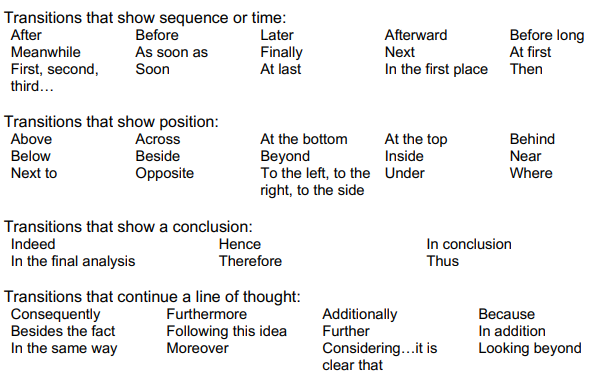6.7: Organization between and within paragraphs
- Page ID
- 75198
Now that you’ve decided how you’re going to organize your essay as a whole, you’re going to start working on getting your points on the page. How are you going to make sure your ideas flow, both within your paragraphs and when moving from paragraph to paragraph? First, note that just as an essay starts with an introduction, moves into the body, and then has a conclusion, paragraphs reflect that same structure:
- Topic sentence
- Body
- Concluding sentence
The topic sentence, like the thesis statement in an essay, gives an overview of the paragraph. The body sentences support the topic sentence with transitions, working within them to help the ideas flow. Then the concluding sentence helps wrap up ideas and/or transition into the paragraph that follows.
Consider the following paragraph from The Atlantic article “Why Do Humans Talk to Animals if They Can’t Understand?” by Arianna Rebolini. The words in green act as transitions within the paragraph:
It’s no stretch to suppose that a person with few or no friends would treat a pet more like a human friend. (topic sentence) Perhaps, too, people speak to their pets because they like to believe the animals understand, and perhaps people like to believe they understand because the alternative is kind of scary. To share a home with a living being whose mind you can’t understand and whose actions you can’t anticipate is to live in a state of unpredictability and disconnectedness. So people imagine a mind that understands, and talk to it. (concluding sentence)
Work cited note: Rebolini, Arianna “Why do humans talk to animals if they can’t understand?” The Atlantic 18 August 2017. https://www.theatlantic.com/health/archive/2017/08/talking-to-pets/537225/
Just like in an essay, you can consider using any of the major organizational methods (order of importance, chronological order, etc.) to guide the ideas of each paragraph. Another good habit to have is to notice the way things are organized in texts you read. You can get good ideas for how to organize your own texts from other well-organized texts. You can also consider the bevy of transitional words and phrases to use within your paragraphs (from oer.galileo.usg.edu/cgi/view...glishtextbooks):
Chart: Common transitional words and phrases


Resources
Table of Common Transitional Words and Phrases: page 40 from Successful College Composition (oer.galileo.usg.edu/cgi/viewcontent.cgi?article=1007&context=englishtextbooks)


